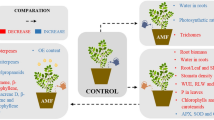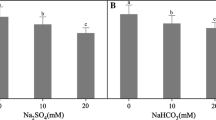Abstract
The effect of two substrates differing in the amount of toxic metals and nutrients on the content of volatile organic compounds in roots of Pinus sylvestris seedlings inoculated with Paxillus involutus, Laccaria laccata, Suillus luteus and a strain of the ectendomycorrhizal fungus Mrg X (Ascomycotina) in pot experiment was investigated. Volatile compounds extracted with a supercritical fluid extraction were primarily terpenes and sesquiterpenes, and they were qualitatively the same in roots of mycorrhizal and nonmycorrhizal plants grown on both substrates. The major monoterpenes were α-pinene, Δ3-carene and β-pinene. On the unpolluted substrate, inoculation of plants with the fungi resulted in a similar amount of the volatiles, while on the polluted substrate the mycorrhizal roots showed significantly lower content of terpenoids than nonmycorrhizal roots. The mycorrhizal fungi showed different effects on the concentrations of several terpenoids on both substrates.
Similar content being viewed by others
References
Asiegbu F.O., Johansson M., Woodward S., Hütterman A. 1998. Biochemistry of the host-parasite interaction. In: (eds) Heterobasidion annosum, Biology, Ecology, Impact and Control, ed. by S. Woodward, J. Stenlid, R. Karjalainen, A. Hüttermann. University Press, Cambridge: 167–193.
Bega R.V., Tarry J. 1966. Influence of pine oleoresins on Fomes annosus. Phytopathology, 56: 870.
Bre W., Gołcz A., KomosaY A., Kozik E., Tyksi ski W. 1997. Nawo enie ro lin ogrodniczych. I Diagnostyka potrzeb nawozowych. Wydawnictwo Akademii Rolniczej im. Augusta Cieszkowskiego w Poznaniu, Pozna: 59–73.
Chakravarty P., Unestam T. 1987. Differential influence of ectomycorrhizae on plant growth and disease resistance in Pinus sylvestris seedlings. J. Phytopath., 120: 104–120.
Cobb F.W., Krstic M., Zavarin E., Barber H.W. 1968. Inhibitory effects of volatile oleoresin components on Fomes annosus and four Ceratocystis species. Phytopathology, 58: 1327–1335.
Doma ski S. 1978. Fungi occurring in forests injured by air polutants in the Upper Silesia and Cracow Industrial Regions of Poland. VI. Higher fungi colonizing the roots of trees in converted forest stands. Acta Soc. Bot. Pol., 47: 285–295.
Duchesne L.C., Peterson R.L., Ellis B.E. 1987. The accumulation of plant-produced antimicrobial compounds in response to ectomycorrhizal fungi: a review. Phytoprotection, 68: 17–27.
Fahn A., Zamski E. 1970. The influence of preassure, wind, wounding and growth substances on the rate of resin duct formation in Pinus halepensis wood. Isr. J. Bot., 19: 429–446.
Fahn A., Werker E., Ben-Tzur P. 1979. Seasonal effects of wounding and growth substances on development of traumatic resin ducts in Cedrus libani. New Phytol., 82: 537–544.
Felner R. 1989. Mycorrhiza-forming fungi as bioindicators of air pollution. Agric. Ecosyst. Environ., 28: 115–120.
Gawdzik J., Mardarowicz M., Suprynowicz Z. 1996. Supercritical fluid extraction of essential oils from the fruits of Archangelica off. Hoffm. and their characterisation by GC/MS. J. High Resol. Chromatogr., 19: 237–240.
Gibbs J.N. 1968. Resin and resistance of conifers to Fomes annosus. Ann. Bot., 32: 649–665.
Goodman R.N., Kiraly Z., Zaitlin M. 1967. The biochemistry and physiology of infections plant disease. D. Van Nostrand Co., Inc. pp. 534.
Grzywacz A., Wa ny J. 1973. The impact of industrial air pollutants on the occurence of several important pathogenic fungi of forest trees in Poland. Eur. J. For. Path., 3: 129–141.
Hart J.H., Wardell J.F., Hemingway R.W. 1975. Formation of oleoresin and lignans in sapwood of white spruce in response to wounding. Phythopathology, 65: 412–417.
Hartley J., Cairney J.W.G., Freestone P., Woods C, Meharg A.A. 1999. The effects of multiple metal contamination on ectomycorrhizal Scots pine (Pinus sylvestris) seedlings. Environ. Pollut., 106: 413–424.
Higuchi T. 1985. Biosynthesis and Biodegradation of Wood Components. Academic Press, Orlando, pp. 679.
Hintikka V. 1970. Selective effect of terpenes on wood-decomposing Hymenomycetes. Karstenia, 11: 28–32.
Jansen A.E., Van Dobben H.F. 1987. Is decline of Cantharellus cibarius in Neyherland due to air pollution? Ambio, 16: 211–213.
Jentschke G., Godbold D.L. 2000. Metal toxicity and ectomycorrhizas. Physiol. Plantarum, 109: 107–116.
Koide R.T., Suomi L., Stevens C.M., McCormick L. 1998. Interactions between needles of Pinus resinosa and ectomycorrhizal fungi. New Phytol., 140: 539–547.
Kowalski S. 1987. Mycotrophy of trees in converted stands remaining under strong pressure of industrial pollution. Angew. Botanik, 61: 65–83.
Krupa S., Fries N. 1971. Studies on ectomycorrhizae of pine. I. Production of volatile organic compounds. Can. J. Bot., 49: 1425–1431.
Krupa S., Nylund J.E. 1972. Studies on ectomycorrhizae of pine. III. Growth inhibition of two root pathogenic fungi by volatile organic constituents of ectomycorrhizal root systems of Pinus sylvestris L. Eur. J. For. Pathol., 2: 88–94.
Krupa S., Andersson J., Marx D.H. 1973. Studies on ectomycorrhizae of pine. IV. Volatile organic constituents in mycorrhizal and nonmycorrhizal root systems of Pinus echinata Mill. Eur. J. For. Pathol., 3: 194–200.
Lo H.C., Schütt P. 1980. Rinderkratzen als Schälschutzmaßnahme. AnatomischeReaktionen der Fichte in Abhängigkeit von Behandlungsmethode und termin. Forstwiss. Cbl., 99: 21–31.
Marx D.H. 1972. Ectomycorrhizae as biological deterrens to pathogenic root infections. Ann. Rev. Phytopath., 10: 429–454.
Melin E., Krupa S. 1971. Studies on ectomycorrhizae of pine. II. Growth inhibition of mycorrhizal fungi by volatile organic constituents of Pinus silvestris L. (Scot pine) roots. Physiol. Plantarum, 25: 337–340.
Molina R., Trappe J. M. 1982. Patterns of ectomycorrhizal host specificity and potential among pacific northwest conifers and fungi. For. Sci., 28: 423–458.
Pachlewski R. 1983. Grzyby symbiotyczne i mikoryza sosny (Pinus sylvestris L.). Prace IBL, 165: 1–133.
Perrin R. 1985. L’aptitude des mycorhizes protéger les plantes contre les maladies: panacée ou chim re? Ann. Sci. For., 42: 453–470.
Piché Y., Fortin J.A., Lafontaine J.G. 1981. Cytoplasmic phenols and polysaccharides in ectomycorrhizal and nonmycorrhizal short roots of pine. New Phytol., 88: 695–703.
Prior C 1976. Resistance by Corsican pine to Fomes annosus. Ann. Bot., 40: 261–279.
Rachwał L., Sienkiewicz A., Komisarek J., Kociałkowski W.Z. 1990. Rozmieszczenie na ró nych gł - boko ciach oraz frakcjonowanie Cu, Pb i Zn w glebach strefy ochronnej hut miedzi w Głogowie. Prace Komisji Nauk Rolnych i Komisji Nauk Le nych, 69: 101–114.
Rühling A., Baath E., Nordgren A., Söderstrom B. 1984. Fungi in metal contaminated soil near the Gusum. Bross Mill, Sweden. Ambio, 13: 34–36.
Schuck H.J. 1977a. The chemical composition of the monoterpene fraction in wounded wood of Picea abies and its significance for the resistance against wood-infecting fungi. Eur. J. For. Path., 7: 175–181.
Schuck H.J. 1977b. Die Wirkung von Monoterpenen auf das Mycelwachstum von Fomes annosus (Fr.) Cooke. Eur. J. For. Path., 7: 374–384.
Schuck H.J. 1982. Monoterpenes and resistance of conifers to fungi. In: Resistance to diseases and pests in forest trees, ed. by H.M. Heybroek, B.R. Stephan, K. von Weissenberg K. Centre for Agricultural Publishing and Documentation, Wageningen, the Netherlands, 169–175.
Shain L. 1967. Resistance of sapwood in stems of loblolly pine to infection by Fomes annosus. Phytopathology, 57: 1034–1045.
Smith W.H. 1987. The atmosphere and the rhizosphere: Linkages with potential significance for forest tree health. In: Technical Bulletin of National Council of the Paper Industry for Air and Stream Improvements, ed by R.O. Blasser R O. New York, 527: 30–94.
Sylvia D.M., Sinclair W.A. 1983a. Suppressive influence of Laccaria laccata on Fusarium oxysporum and on Douglas-fir seedlings. Phytopathology, 73: 384–389.
Sylvia D.M., Sinclair W.A. 1983b. Phenolic compounds and resistance to fungal pathogens induced in primary roots of Douglas-fir seedlings by the ectomycorrhizal fungus Laccaria laccata. Phytopathology, 73: 390–397.
Thibault-Balesdent M., Delatour C. 1985. Variabilité du comportement de Heterobasidion annosum (Fr.) Bref. à trois monoterpènes. Eur. J. For. Path., 15: 301–307.
Varese T.C., Portinaro S., Trotta A., Scannerini S., Luppi-Mosca A.M., Martinotti M.G. 1996. Bacteria associated with Suillus grevillei sporocarps and ectendomycorrhizae and their effects on in vitro growth of the mycobiont. Symbiosis-Rehovot, 21: 129–147.
Werner A. 1993. Pathological anatomy of thin woody roots of Scots pine invaded by Heterobasidion annosum (Fr.) Bref. Arboretum Kórnickie, 38: 113–129.
Werner A., Idzikowska K. 2001. Host/pathogen interactions between Scots pine seedlings (Pinus sylvestris L.) and the P-strains of Heterobasidion annosum (Fr.) Bref. in pure culture. Acta Soc. Bot. Pol., 70: 119–132.
Werner A., Karolewski P. Effect of toxic metals, content of nutrients and inoculation with mycorrhizal fungi on the level of phenolics in roots and growth of Scots pine seedlings. (in this issue)
Author information
Authors and Affiliations
Rights and permissions
About this article
Cite this article
Werner, A., Napierała-Filipiak, A., Mardarowicz, M. et al. The effects of heavy metals, content of nutrients and inoculation with mycorrhizal fungi on the level of terpenoids in roots of Pinus sylvestris seedlings. Acta Physiol Plant 26, 187–196 (2004). https://doi.org/10.1007/s11738-004-0008-9
Received:
Accepted:
Issue Date:
DOI: https://doi.org/10.1007/s11738-004-0008-9




